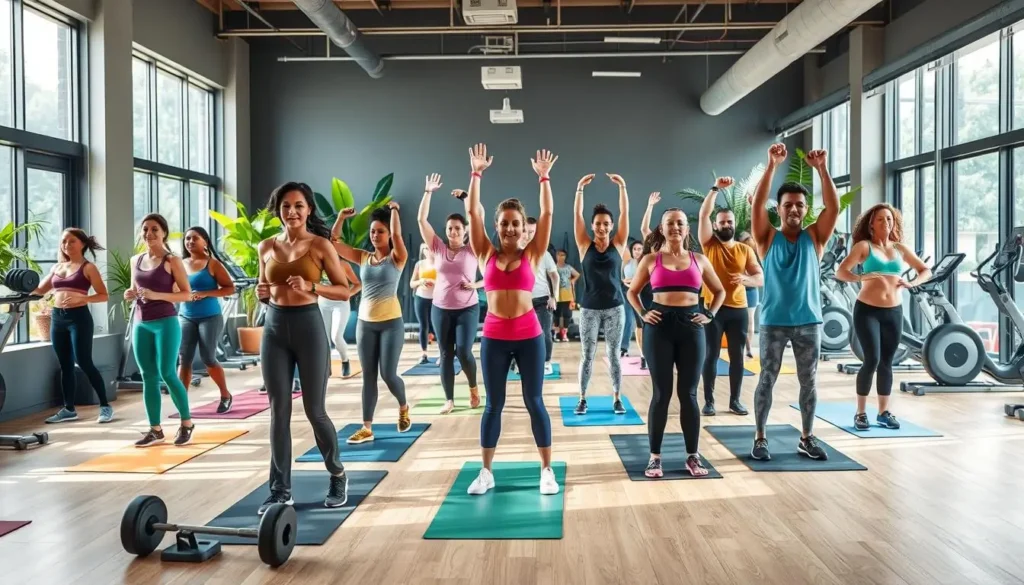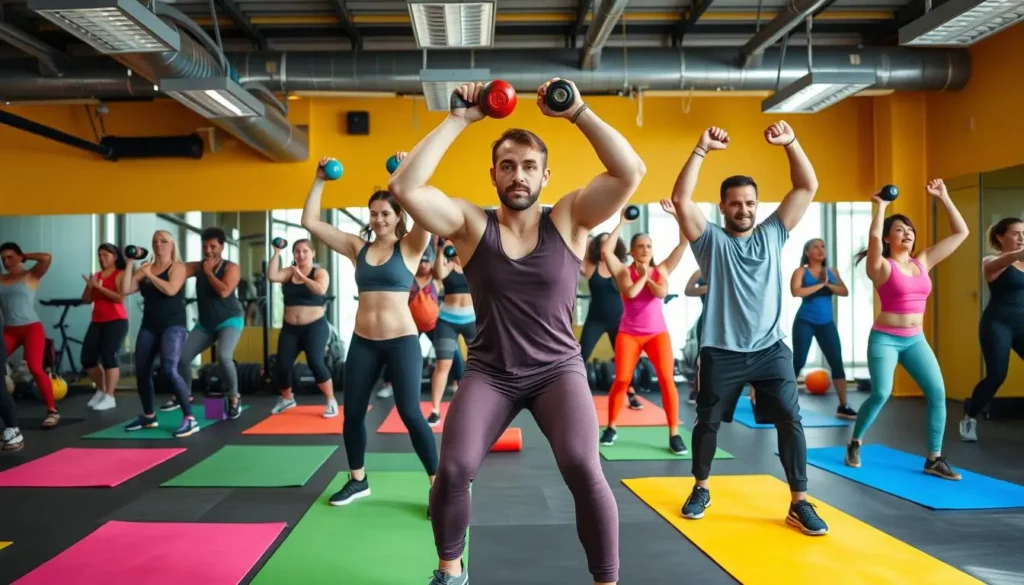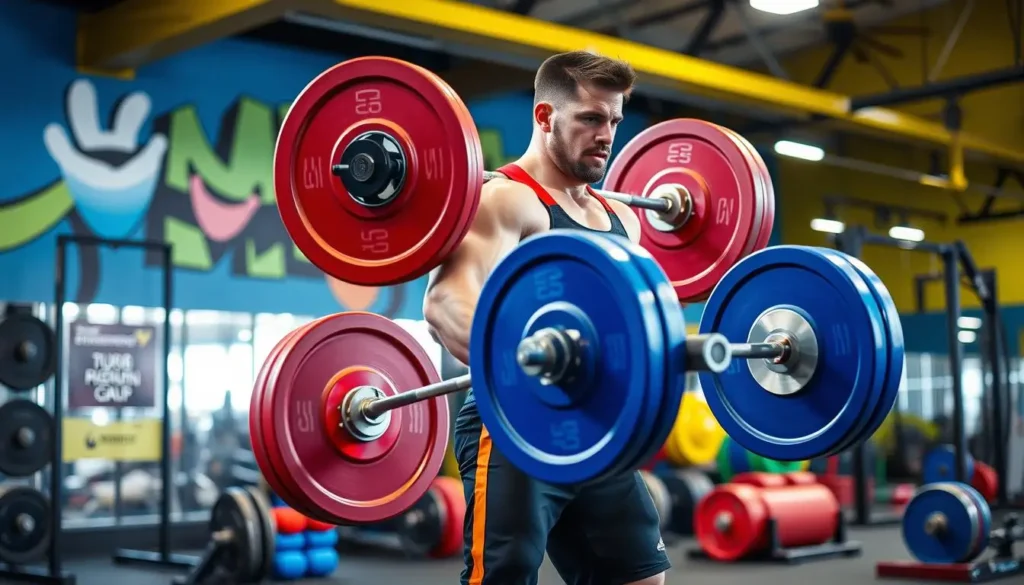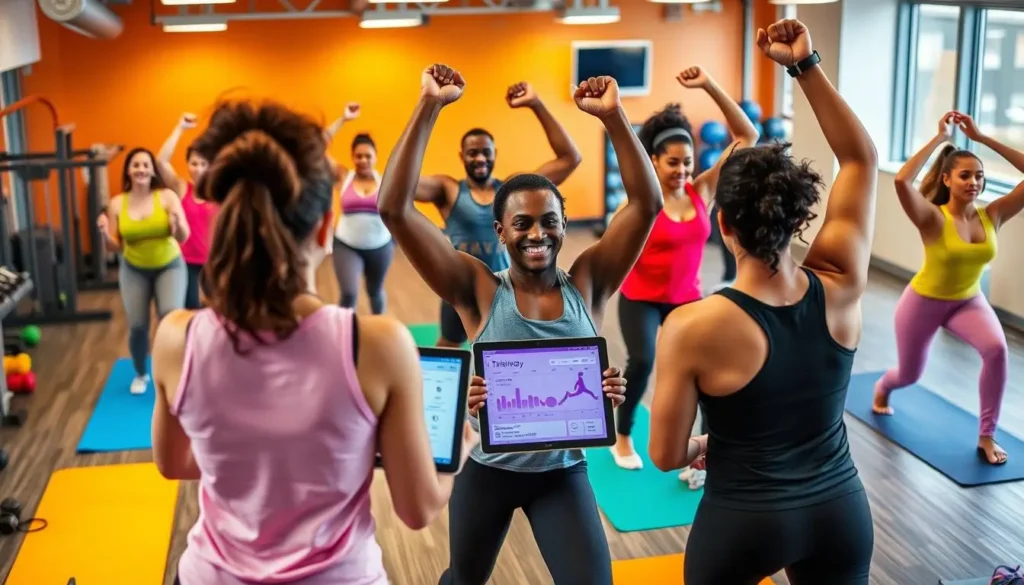Are you having trouble finding the perfect workout routine? With so many options, it’s hard to know where to begin. Studies show that more people are not getting enough exercise from 2001 to 2016. A 2021 survey found people still want to join effective workout programs.
Research says short, frequent workouts can be just as good as longer ones. This is true if you do the same amount of work.

Table of Contents
Key Takeaways
- Effective workout programs can be tailored to your fitness level and goals
- Worldwide trends show an increase in physical activity levels from 2001 to 2016
- Short, frequent exercise sessions can be as effective as longer, less frequent workouts
- Resistance training frequency and volume impact muscle strength and hypertrophy
- Customizable workout programs are available to meet your specific needs
Understanding Fitness Levels
Getting fit is a journey. Knowing your current fitness level is the first step. It helps you reach your goals. Whether you’re new or experienced, fitness levels, exercise experience, and workout difficulty are key. They help make a good training progression.
Beginner Level
For those new to fitness, the beginner level is great. It’s for those with little exercise experience. Beginner workouts start with bodyweight exercises, basic yoga, and easy cardio.
Intermediate Level
When you get better, the intermediate level is next. It’s harder than beginner. You’ll do weight training, tough yoga, and HIIT to get even better.
Advanced Level
For those who are very fit, the advanced level is perfect. It includes Olympic weightlifting, hard yoga, and plyometric workouts. These workouts challenge you and help you grow in your fitness journey.
“Knowing your fitness levels is the first step to reaching your goals. It helps you make a training progression that fits you.”
No matter your fitness level, this guide helps you. It makes sure you find the right workout difficulty. This helps you reach your health and fitness dreams.
Beginner Workout Programs
For those just starting, beginner workouts build a strong base. They focus on foundational exercises, bodyweight training, and low-impact cardio. This helps new exercisers get stronger, more flexible, and more fit.
Bodyweight Circuit Training
A good bodyweight circuit training for beginners includes squats, push-ups, lunges, and planks. These exercises work many muscles at once, making the body stronger. You do each exercise for a set number of reps, rest a bit, and then do more as you get better.
Basic Yoga Sequence
Yoga for beginners helps with flexibility, balance, and calmness. A basic yoga routine might have poses like Downward Dog, Warrior, and Tree Pose. These poses help you breathe right and connect your body and mind. Yoga is great for beginners because it makes you feel better physically and mentally.
Low-Intensity Cardio
Low-impact cardio like walking fast or cycling is perfect for beginners. It gets your heart rate up and makes your heart stronger without hurting your body too much. You can do these activities for a long time, helping you get more stamina and fit.
By mixing bodyweight training, yoga, and low-impact cardio, beginner workouts give a balanced way to stay active. They help you build a strong fitness base.
| Workout Type | Duration | Equipment | Frequency |
|---|---|---|---|
| Bodyweight Circuit Training | 10-35 minutes | Bodyweight | 5 days per week |
| Basic Yoga Sequence | 10-30 minutes | Yoga mat | 3-4 days per week |
| Low-Intensity Cardio | 20-45 minutes | Treadmill, stationary bike | 3-4 days per week |
These beginner workouts are made to help newbies build a strong base. They help you get fitter and keep up good habits.
“The key to success for any beginner is to start small, focus on proper form, and gradually increase the intensity and volume of their workouts over time.”
Intermediate Workout Programs
Fitness fans move up from beginner to intermediate levels. They look for workouts that challenge them more. These programs help them grow stronger and better.
They focus on doing things right, being mindful, and training smart. This helps improve strength, endurance, and health.
Weight Training Circuits
Intermediate weight training uses big exercises like bench presses and deadlifts. These workouts make muscles stronger. They also make sure you use the right form.
These circuits work on different muscle groups each day. They use sets of 3 to 5 and reps of 8 to 10. This makes training focused and effective.
Intermediate Yoga Flow
Yoga is key for intermediate workouts. It helps with balance, flexibility, and being aware of your body. Intermediate yoga includes harder poses like arm balances and inversions.
This practice boosts physical skills and mental focus. It also helps deal with stress better.
High-Intensity Interval Training (HIIT)
HIIT is popular for those who want to get their heart rate up and burn calories. It mixes intense exercise with short breaks. This makes you fitter fast.
HIIT uses bodyweight exercises and plyometrics. It’s a quick way to get great results.

Intermediate workouts mix weight training, yoga, and HIIT. This mix helps people grow stronger, more flexible, and better in endurance.
Advanced Workout Programs
For those who love to push their limits, advanced workouts are exciting. They mix intensity, precision, and challenge. These programs test your strength, power, and endurance.
Olympic Weightlifting Techniques
Olympic weightlifting, like the snatch and clean and jerk, need strength and technique. The workout is six days a week, with two sessions each day. It uses supersets, trisets, and drop sets to grow muscles.
It has lots of sets, 4 for each exercise, to build strength. It uses different rep ranges to grow muscles and improve endurance. Rest for 60 to 90 seconds between sets is key for recovery.
It also includes exercises to prevent injuries and improve training. Stretching and warm-ups are important to avoid injuries and get muscles ready.
Advanced Yoga Poses and Sequences
Advanced yoga poses and sequences challenge your flexibility, balance, and strength. Poses like the Peacock and King Dancer are very hard. They need years of practice and knowing your body well.
Plyometric Workouts
Plyometric exercises, like box jumps and burpees, boost speed, power, and heart health. About 70-80% of workouts should focus on strength training. This includes squats, deadlifts, and bench presses.
Rest for 60-90 seconds between strength training sets is best for recovery and performance. HIIT classes should last 45 minutes to improve heart health and burn fat. Bodyweight circuit training should have 5 rounds with little rest to keep intensity high.
Evening yoga or mobility classes should last 45 minutes to improve flexibility and aid recovery. Active recovery days should be low-impact and last 45 minutes to help muscles recover. Power and agility training includes 4 sets of 4-6 reps for explosive strength and coordination.
Cross-training sessions should last 60 minutes to improve fitness with varied movements. Outdoor activities should last 90 minutes to work different muscles, boost heart health, and offer a change of scene. Morning GROUP classes should last 60 minutes to improve flexibility, connect mind and body, and relax.
Gaining muscle and improving body shape needs progressive overload. The muscle confusion principle means changing workout routines to avoid getting used to them. A structured program helps track progress and avoid plateaus.
Varying training keeps motivation up, but changing exercises too much can hurt muscle growth. Beginners do well with full-body workouts that target all major muscle groups. Intermediate to advanced bodybuilders benefit from full-body training for balanced growth.
A three-day training split allows for more sets and reps per muscle group than full-body workouts for advanced beginners or intermediates. A four-day split focuses more on each muscle group, promoting better recovery and muscle growth. Mixing compound and isolation movements targets every muscle fiber for good bodybuilding results.

“The true essence of an advanced workout lies in its ability to push the boundaries of human potential, unlocking new levels of strength, flexibility, and endurance.”
workout programs Customization
Personalization is key to unlocking your fitness journey. Knowing your fitness level, goals, and needs helps create a workout plan that works for you. Regular fitness checks are important for this, giving insights for your workout design.
At the start, fitness checks focus on strength, flexibility, and heart health. As you get better, these checks get more detailed. They look at body shape, muscle balance, and how you adapt to training. This makes sure your workout stays right for you as you get stronger.
Expert coaches create custom workout plans for you. It’s best to work out 3-4 times a week for 30 minutes to see results. You can start seeing changes in a few weeks.
These plans last 12 weeks, then might need to change based on how you’re doing. You pay once for the plan, and there’s no ongoing cost. You won’t get personal diet advice.

Success in workout plans comes from checking your progress and changing your plan as needed. This keeps you on track to reach your fitness goals and stay healthy.
Remember, your fitness journey is unique, and a customized program is the surest path to reaching your full potential.
“Consistency is the key to unlocking your fitness potential. With a customized workout plan, you can stay on track and see tangible results.” – Fitness Coach, John Doe
| Fitness Assessment Focus | Beginner Level | Intermediate Level | Advanced Level |
|---|---|---|---|
| Baseline Metrics | Strength, Flexibility, Cardio Endurance | Body Composition, Muscle Imbalances | Training Adaptations, Specific Goals |
Goal Setting for Effective Training
Setting fitness goals is key to a good training plan. You might want to lose weight, build muscle, or get healthier. Having a clear goal is very important.
Make your goals specific and measurable. Use the SMART method: Specific, Measurable, Achievable, Relevant, and Time-Bound.
For example, aim to work out three times a week. Or, try to run shorter distances and get better each week. You can also try new workouts every month until you find one you like. Start with easy push-ups and get better slowly.
Don’t forget to include rest days in your plan. Drinking water all day is also a good goal for your health. Having a goal, like running a 5k, helps you track your progress and stay motivated.
Setting fitness goals does more than just make you healthier. They help you stay focused and see how far you’ve come. Plus, having goals that mean something to you keeps you motivated and helps you succeed.

Make sure your fitness goals fit you. Set goals that are realistic, achievable, and have a deadline. This way, you can improve yourself and enjoy the benefits of regular training.
The FITT Principle
Making a good workout plan is like following a recipe. The FITT principle helps make a balanced and personal exercise plan. It lets you adjust your workouts to fit your level, goals, and likes. This way, you can keep getting better and enjoy your fitness journey more.
Frequency
For cardio, aim for three workouts a week, or five to six for losing weight. For strength training, do it three to four times a week. Remember to take rest days to let muscles heal and avoid too much strain.
Intensity
Use the FITT principle to find the right heart rate zone for your workouts. You need at least 150 minutes of moderate or 75 minutes of high-intensity exercise weekly. For a 25-year-old, the heart rate zone should be 95 to 162 beats per minute. A heart rate monitor can help track your heart rate.
Time
Cardio workouts should last at least 30 minutes, with longer times for different activities. Resistance workouts usually last 45 to 60 minutes.
Type
Strength training includes weight lifting and bodyweight exercises like squats and pushups. Cardio activities like running, swimming, walking, and dancing are also part of it. Using the FITT principle helps avoid plateaus, boredom, and injuries, and fits all fitness levels.
It’s good to mix up your workouts to work different muscles and avoid getting bored. Always talk to a doctor before starting a new exercise program, especially if you have health issues. Start slowly and increase the intensity as you get more comfortable and fit.
“The FITT principle is like a roadmap for creating effective, personalized workout programs that can help you reach your fitness goals, stay motivated, and prevent injuries.”
Strength Training Fundamentals
Strength training is key for a good fitness plan. It helps build muscle, strengthen bones, and boost metabolism. It’s important to do exercises right and get stronger little by little. This way, you can reach your fitness goals, like losing weight or getting stronger.
Strength training includes many types of exercises, like lifting weights or doing bodyweight moves. You can adjust how many times you do an exercise and how heavy it is to meet your goals. Doing strength training regularly helps keep your muscles strong and improves your health.
Adding strength training to your routine is good for everyone, no matter if you’re new or experienced. It helps keep your muscles strong, makes your bones denser, and lowers the risk of diseases. Strength training makes you fitter and improves your life quality.
Best Fitness Books for Beginners: 7 Essential Reads to Transform Your Health Journey
Starting your fitness journey can feel overwhelming, especially with countless workout routines, nutrition plans, and conflicting advice online. The best fitness books for beginners provide structured, evidence-based guidance that cuts through the noise and sets you up for long-term success. Whether you’re looking to lose weight, build muscle, or simply improve your overall health, the right book can become your trusted companion on this transformative journey.
Buy vitamins and supplements
Buy bestselling books online
FAQ
Where do I start if I’m new to exercise?
How do I craft the right workout program for my fitness level?
What are some beginner-friendly workout options?
How can I take my fitness to the next level?
What are some advanced workout options?
How important are assessment techniques in fitness?
How should I set goals for my fitness journey?
What is the FITT principle and how does it apply to workout programming?
Why is strength training important in a fitness program?
Source Links
- No Time to Lift? Designing Time-Efficient Training Programs for Strength and Hypertrophy: A Narrative Review
- 5 basics of a well-rounded fitness routine
- Effective workout programs for different fitness levels: A gym coach’s guide
- 5 steps to start a fitness program
- The Complete 4-Week Beginner’s Workout Program – Muscle & Fitness
- 30-Day Beginner Workout Plan (Videos) | Nourish Move Love
- The Beginner Weight Training Workout Routine
- How To Workout: The Guide of How To Get A Physique You Will Love
- Intermediate Workout Plan – Fitness Project
- Unleash Your Full Potential: Advanced Workout Plan With Tips for Peak Performance – Fitness Project
- 15 Best Bodybuilding Programs: Beginner to Advanced
- Free Workout Plans – Custom exercise routines by FreeTrainers.com
- Custom Workout Plan | Built With Science
- 10 Realistic Fitness Goals, Recommended by Personal Trainers
- Setting Fitness Goals is Essential to Long-Term Success | ISSA
- The FITT Principle: Benefits & How to Use It
- Here’s Everything You Need to Know to Start Weight Lifting
- Strength training: Get stronger, leaner, healthier




